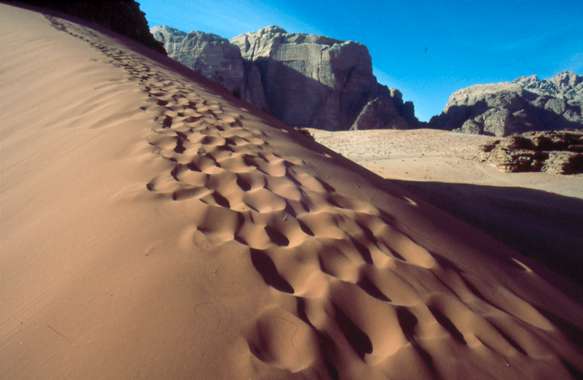|
|
||
|
. Adventures in desert . Adventure with nomads . Adventures in canyons . Adventures by camels . Adventures by horses . Adventures by jeeps . home page |
||
|
The desert in Jordan: Jordan is a relatively small country situated at the junction of the Levantine and Arabian areas of the Middle East. The country is bordered on the north by Syria, to the east by Iraq, and by Saudi Arabia on the east and south. To the west is Israel and the occupied West Bank, while Jordan's only outlet to the sea, the Gulf of Aqaba, is to the south. Jordan occupies an area of approximately 96,188 square kilometers including the Dead Sea, making it similar in size to Austria or Portugal. However, Jordan's diverse terrain and landscape belie its actual size, demonstrating a variety usually found only in large countries. Western Jordan has essentially a Mediterranean climate with a hot, dry summer, a cool, wet winter and two short transitional seasons. However, about 75% of the country can be described as having a desert climate with less than 200 mm. of rain annually. Jordan can be divided into three main geographic and climatic areas: the Jordan Valley, the Mountain Heights Plateau, and the eastern desert, or Badia region. Wadi Araba: South of the Dead Sea, the Jordan Valley runs on through hot, dry Wadi 'Araba. This spectacular valley is 155 kilometers long and is known for the sheer, barren sides of its mountains. Its primary economic contribution is through potash mining. Wadi ‘Araba rises from 300 meters below sea level at its northern end to 355 meters above sea level at Jabal Risha, and then drops down again to sea level at Aqaba. Eastern desert of Badia: Comprising around 75% of Jordan, this area of desert and desert steppe is part of what is known as the North Arab Desert. It stretches into Syria, Iraq and Saudi Arabia, with elevations varying between 600 and 900 meters above sea level. Climate in the Badia varies widely between day and night, and between summer and winter. Daytime summer temperatures can exceed 40 C, while winter nights can be very cold, dry and windy. Rainfall is minimal throughout the year, averaging less than 50 millimeters annually. Although all the regions of the Badia (or desert) are united by their harsh desert climate, similar vegetation types and sparse concentrations of population, they vary considerably according to their underlying geology. The volcanic formations of the northern Basalt Desert extend into Syria and Saudi Arabia, and are recognizable by the black basalt boulders which cover the landscape. East of the Basalt Desert, the Rweishid Desert is an undulating limestone plateau which extends to the Iraqi border. There is some grassland in this area, and some agriculture is practiced there. Northeast of Amman, the Eastern Desert is crossed by a multitude of vegetated wadis, and includes the Azraq Oasis and the Shomari Wildlife Reserve. To the south of Amman is the Central Desert, while Wadi Sarhan on Jordan's eastern border drains north into Azraq. Al-Jafr Basin, south of the Central Desert, is crossed by a number of broad, sparsely-vegetated wadis. South of al-Jafr and east of the Rum Desert, al-Mudawwara Desert is characterized by isolated hills and low rocky mountains separated by broad, sandy wadis. The most famous desert in Jordan is the Rum Desert, home of the wondrous Wadi Rum landscape. Towering sandstone mesas dominate this arid area, producing one of the most fantastic desert-scapes in the world. Wadi Rum: Wadi Rum holds
plants both rare and endemic to its ecosystem. A greater emphasis has been
put on the Wadi's fauna after a baseline survey detected the existence of
the Gray Wolf, Blandford's Fox, the Sand Cat and the Ibex within the area.
Additionally, the site is an ideal area for bird watching with its 110
recorded species. |
||
|
|
Tel: +962777282730, +962777517069 Fax: 00962 3 2154 999 E-mail: info@jordanbeauty.com Web: www.jordanbeauty.com |
|

